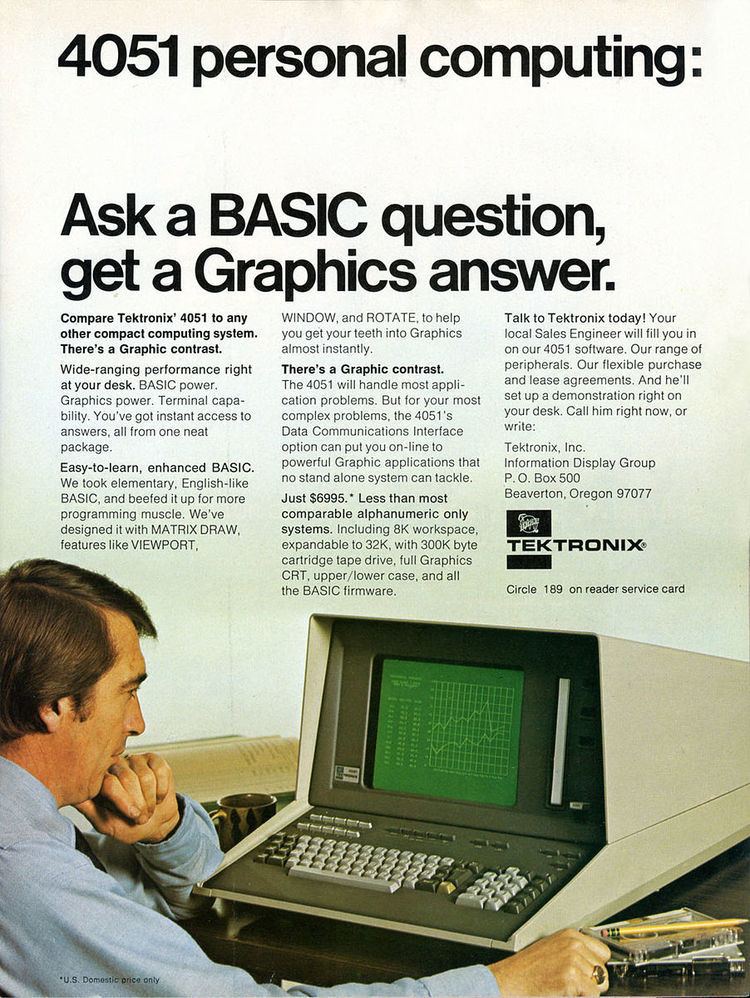 | ||
The Tektronix 4050 was a series of three computer graphics microcomputers produced by Tektronix in the late 1970s through the early 1980s. The display technology was similar to the Tektronix 4010 terminal, using a storage tube display to avoid the need for video RAM. They were all-in-one designs with the display, keyboard, CPU and DC300 tape drive in a single desktop case. They also included a GPIB parallel bus interface for controlling lab and test equipment as well as connecting to external peripherals. A simple operating system and BASIC interpreter were included in ROM.
A key concept of the systems was the use of a storage tube for the display. This allowed the screen to retain images drawn to it, eliminating the need for a framebuffer, computer memory devoted to the display. Most systems of the era had limited resolution due to the expense of the buffer needed to hold higher resolution images, but this was eliminated in the 4050s and allowed the resolution to be as high as the hardware could handle, which was ostensibly 1024 by 1024 but limited by the physical layout of the screen to 1024 by 780. It also allowed the machine to dedicate all of its memory to the programs running on it, as opposed to partitioning off a section for the buffer.
The first model, the 4051, was based on 8-bit Motorola 6800 running at a 1 MHz. It normally shipped with 8 kB of RAM and was expandable using 8 kB modules to 32 kB. The remaining 32 kB of address space was reserved for ROM, which could be expanded using two external ROM cartridge of 8 kB each. It included six character sets in ROM and an extended dialect of BASIC that included various vector drawing commands. The 4051 was released in 1975 for the base price of $5,995. Adding the optional RS-232 interface allowed it to emulate a Tektronix 4012 terminal.
The second model was the 4052, which in spite of the similar name was a very different system. This had a CPU based on four AMD 2901 4-bit bit-slice processors used together to make a single 16-bit processor. It could also be used in a 6800-compatible mode, allowing it to run software from the 4051, although it did so much faster than the original 4051. Released in 1978, it came with a full 32 kB of RAM for $9,795, and could be expanded to 64 kB for another $1,995. The 4054 was a version of the 4052 build around the 19" screen from the 4014 terminal rather than the 11" screen from the 4012, increasing resolution to 4,096 by 3,072.
External storage units were available for the 405x series computers. The 4924 was an external version of the internal DC300 tape drive. The 4907 used single or dual Shugart 851R 8 inch floppy drives with 64 kB floppies and the larger, 2-drawer filing cabinet sized, 4909 storage unit used a CDC 96 megabyte hard drive with the first 16 megabytes in the form of a removable disc-pack. Two sizes of the 4956 graphics tablet offered a slow process for inputing from paper drawings. The 4952 joystick was used for graphics input.
Because the direct view storage tubes do not flicker as do conventional CRTs, and because the BASIC programming interface allowed simple, rapid rendering of vector graphic displays, the 405x series were used in many theatrical contexts. In particular, 405x computers can frequently be seen in early Battlestar Galactica sets.
The graphic display software was based upon software originally developed in the 1960s by Corning Glass Works for their Type 904 graphics terminal. The display for this system had characteristics to the similar to those of Tektronix storage tube display. It used small pixel regions composed of photochromic glass, which could be darkened (forming a black line image) by writing, and would display this persistently until the entire display was erased. When Corning left the market this software base was sold to Tektronix.
The original demo included an artillery game which was later adapted by high school students at Lindbergh High School in Renton, Washington to the HP 9830, and also adapted by Hewlett Packard for the HP 2647 intelligent graphics terminal demo tape and eventually similar games in Microsoft BASIC for the IBM-PC. Other games for the Tektronix included Weather Wars, with users directing lightning bolts and tornados against opponents in an environment affected by wind.
